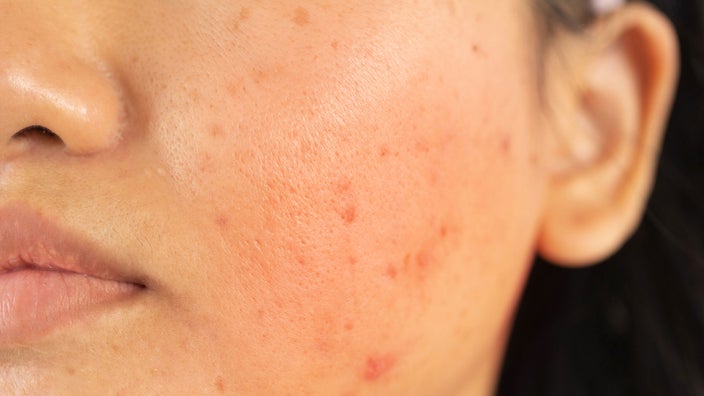
Niacin Flush: Is This Common Supplement Side Effect Harmful?
Key takeaways:
Niacin is a B vitamin that helps with energy and healthy cholesterol levels.
Niacin supplements can cause a flush of red, warm, or itchy skin on the face, arms, and chest. But it’s not dangerous.
Taking the supplement with an apple and avoiding hot showers can help lower the chances of experiencing niacin flush.
Access savings on related medications
Table of contents

Niacin is a B vitamin commonly found in multivitamin supplements that claim to improve heart health and boost energy levels. But taking large doses of niacin — like those in supplements — can cause the face to temporarily redden, or flush. This side effect isn’t dangerous. But there are some important things to know about niacin if you’re considering this supplement.
What is niacin?
Niacin (nicotinic acid) is a B vitamin — B3, to be exact.
Niacin is naturally present in many foods. And most people get enough niacin from:
Meat products, like poultry, beef, and fish
Plant foods, including nuts, legumes, and grains
Breads, cereals, and infant formula (fortified with niacin)
But niacin deficiency can occur. It can happen from a lack of access to healthy foods. Or it can be due to a medical condition that affects absorption (how the body processes and uses different substances).
In cells, niacin helps convert food into energy the body can use. Specifically, it’s necessary to make the coenzyme nicotinamide adenine dinucleotide (NAD). NAD then becomes nicotinamide adenine dinucleotide phosphate (NADP), which is important for metabolism and DNA repair.
Your primary care provider might prescribe niacin to help improve cholesterol levels. Niacin has been shown to help raise high-density lipoproteins (HDL, or “good” cholesterol) and lower low-density lipoproteins (LDL, or “bad” cholesterol). While it may improve cholesterol numbers, niacin hasn’t been shown to reduce risks of heart attacks or strokes. But it’s still sometimes used along with other medications like statins.
Some vitamin supplements also use niacin in energy-boosting capsules. But no research indicates that an extra dose of niacin will boost energy.
What is niacin flush?
Niacin flush is a side effect that can happen when a person consumes niacin. While it’s most common to get flushing with high doses of niacin, it can also happen with standard doses.
Flushing happens because niacin causes small blood vessels near the skin to widen. As a result, the skin gets warm and red. Niacin flush is most common on the face, arms, and chest. Skin symptoms can include:
Reddening
Tingling
Burning
Itching
Warmth
The flush isn’t dangerous, but it’s bothersome enough that some people stop taking their medication because of it.
How much niacin does it take to cause niacin flush?
Reports suggest that 30 mg to 50 mg of nicotinic acid is enough to cause the flush. But you’re unlikely to consume enough niacin from food sources to cause a flush. For example, a serving of canned tuna contains about 8 mg of niacin, and a serving of peanuts contains around 4 mg.
But, if you take supplements or consume energy drinks, you may be getting higher niacin doses without realizing it. For example, a multivitamin can contain as much as 20 mg of niacin. And a B complex vitamin can have 20 mg to 40 mg of niacin. Some energy drinks contain as much as 35 mg or more.
Some people take much higher doses of niacin for health benefits. When niacin is recommended for cholesterol benefits, the dose of niacin can be as much as 1,500 mg to 3,000 mg per day.
How long does flushing last with niacin?
How long the flushing lasts depends on a few different things, like the dose and the formulation you take. For example, with immediate-release niacin, you may get a flush within 30 minutes, and it can last about 1 hour. On the other hand, if you take extended-release niacin, which slows down the absorption, the flush symptoms may be less intense.
And if you take niacin regularly, the flush symptoms may lessen over time as your body gets used to it.
How much niacin does a person need?
In the U.S., most people get the recommended amount of niacin from food sources. Only 1% of adults in the U.S. get less than the recommended amount of niacin from food sources.
The table below contains the recommended amounts of niacin.
Age | Male | Female | Pregnancy | Nursing |
Birth to 6 months | 2 mg | 2 mg | ||
7-12 months | 4 mg | 4 mg | ||
1-3 years | 6 mg | 6 mg | ||
4-8 years | 8 mg | 8 mg | ||
9-13 years | 12 mg | 12 mg | ||
14-18 years | 16 mg | 14 mg | 18 mg | 17 mg |
19+ years | 16 mg | 14 mg | 18 mg | 17 mg |
Adults shouldn’t get more than 35 mg of niacin per day, unless a healthcare professional recommends it. This is when niacin flush usually starts. The typical daily intake for niacin is 18 mg for women and 28 mg for men.
How can you prevent niacin flush?
If your healthcare team recommends you take a niacin supplement, and you’re experiencing niacin flush, there are some steps you can take to lessen your symptoms:
Take it with food. Taking the supplement with a snack, especially an apple, can help.
Avoid spicy foods, hot drinks, and hot showers. You don’t have to avoid these completely, but timing them away from when you take your niacin supplement can help prevent flushing.
Build up your dose gradually. Studies have shown that people can build up a tolerance to niacin, which lowers their likelihood of niacin flush. So start low and build up your daily dose gradually.
Try a different formula. There are some “no-flush” niacin supplements. These are slow-release capsules, so the full dose isn’t absorbed all at once. This helps lower the likelihood of a flush. Inositol hexanicotinate is another option. It’s formulated in a lab and causes less flushing.
Take an aspirin. Taking 325 mg of aspirin a half hour before the niacin supplement can lower your risk of a flush. Be sure to talk with your healthcare team about this option first. Taking aspirin every day isn’t right for everyone.
Are there other risks to taking niacin?
There are other risks associated with taking niacin, especially if you take it in high doses:
Cardiovascular disease: While niacin improves LDL cholesterol levels, this doesn’t translate into a lower risk of heart attack or stroke. And emerging research shows that excess niacin may actually increase the risk of heart attacks, strokes, and cardiovascular death. It does this by increasing blood vessel inflammation and atherosclerosis.
Liver damage: Long-term use of niacin, especially the slow-release formulas, can cause liver problems like hepatitis and liver failure.
Gastrointestinal symptoms: Niacin may cause stomach upset, like diarrhea or vomiting.
Skin symptoms: Niacin can cause prolonged flushing and other skin symptoms, like itching or rash.
Medication interactions: Niacin can interact with medications, including some for diabetes, blood pressure, and tuberculosis.
Always talk with your healthcare team or pharmacist before adding supplements.
The bottom line
Niacin supplements can cause an uncomfortable yet harmless flush that usually lasts about an hour. The flush becomes less noticeable as your body gets used to the niacin supplement dose. You can prevent niacin flush by taking the supplement with food or by avoiding certain foods and drinks. That said, always make sure to talk with your healthcare team or pharmacist before starting or stopping any supplements.
Why trust our experts?


References
Djadjo, S., et al. (2023). Niacin. StatPearls.
Ferrell, M., et al. (2024). A terminal metabolite of niacin promotes vascular inflammation and contributes to cardiovascular disease risk. Nature.
Habibe, M. N., et al. (2023). Niacin toxicity. StatPearls.
Institute of Medicine. (1998). Dietary reference intakes for thiamin, riboflavin, niacin, vitamin b6, folate, vitamin b12, pantothenic acid, biotin, and choline. National Academies Press.
Jacobson, T. A. (2010). A “hot” topic in dyslipidemia management– “how to beat a flush’: Optimizing niacin tolerability to promote long-term treatment adherence and coronary disease prevention. Mayo Clinic Proceedings.
Jagim, A. R., et al. (2022). Prevalence and amounts of common ingredients found in energy drinks and shots. Nutrients.
Kamanna, V. S., et al. (2009). The mechanism and mitigation of niacin-induced flushing. International Journal of Clinical Practice.
MedlinePlus. (2022). Niacin for cholesterol.
Moriarty, P. M., et al. (2013). Apple pectin for the reduction of niacin-induced flushing. Journal of Clinical Lipidology.
National Institutes of Health. (2024). How excess niacin may promote cardiovascular disease.
Office of Dietary Supplements. (2021). Niacin: Fact sheet for consumers. National Institute of Health.
Office of Dietary Supplements. (2022). Niacin: Fact sheet for health professionals. National Institute of Health.
Schandelmaier, S., et al. (2017). Niacin for primary and secondary prevention of cardiovascular events. Cochrane Database System Reviews.
Was this page helpful?
Browse medications
View AllResearch prescriptions and over-the-counter medications from A to Z, compare drug prices, and start saving.





